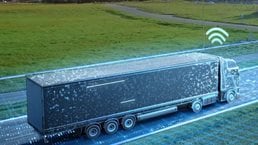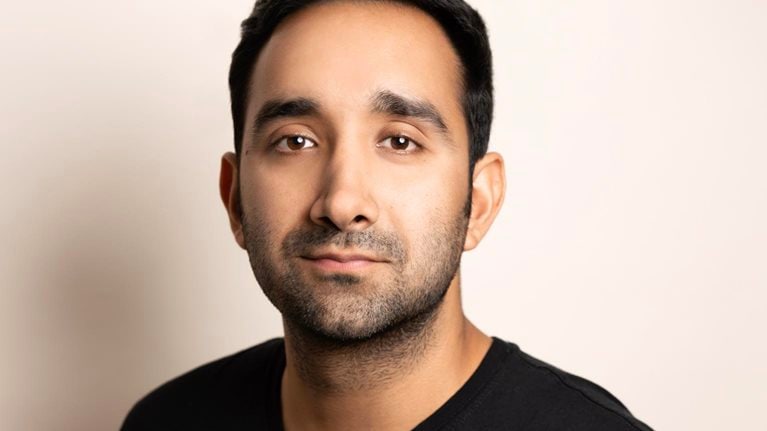A Silicon Valley pitch that involves the phrase “It’s Uber for ... ” will probably elicit skeptical eyerolls from investors, who know that many such proposals don’t live up to their promise. However, when Lior Ron says “Uber for trucks,” ears prick up. That’s because no other entrepreneur can boast full access to all of Uber’s technologies.
Ron is the head of Uber Freight, the tech giant’s logistics spin-off. Launched in 2017 as an autonomous business division within Uber, Uber Freight connects shippers to carriers with capacity. “We stand on the shoulders of a giant,” says Ron, whose team has raised more than $1 billion from external sources.
At a time when the trucking industry is plagued by rising fuel prices, worsening inefficiency, and an aging workforce, Ron’s mission is to “simplify logistics to help communities thrive.” His method? A radical technology-first approach, which he believes cultivates trust, reduces inefficiencies (and therefore costs), and enhances the earnings potential of carriers.
Today, Uber Freight serves shippers of all sizes, from Fortune 500 companies to fairly small independent businesses, as well as the 1.7 million truck drivers across North America who are on it. The platform opens up a new revenue stream for truck companies, which now have another way to book and process loads.
Naturally, finding success in the logistics market is much more complicated than copy-and-pasting the parent company’s technology in a new sector. As Ron told McKinsey’s Vik Krishnan in a recent interview, the business has had to acquire new capabilities quickly and to deepen its logistics understanding and expertise while retaining a start-up’s velocity and agility. Read on to learn how Uber Freight achieved this and where Ron sees the company in five years. This interview has been lightly edited.
McKinsey: What’s the impetus behind Uber Freight?
Lior Ron: We’re trying to ease a very acute pain for this “ginormous” industry that’s responsible for moving everything around us but is incredibly inefficient. Everything in this building was in a truck at some point. In fact, around 70 percent of things in the US are delivered by trucks. But there’s a lot of friction in the coordination between the shippers and truck drivers in the US—a lot of it is still done via fax, phone, and paper. As a result, whenever you see a truck next to you on the highway, there’s a 30 percent chance that it’s completely empty.
At the same time, the cost of trucking is rising, and there are more challenges attracting and retaining drivers. The average age of a truck driver is now 55. The baby boomers are aging out of the industry, and those that are still in it are hard to pin down—you have to pick up the phone and call them 25 times to organize the movement of one truck.
What we want to do with Uber Freight is to simplify the movement of goods and streamline the process by digitizing all of the supply chain infrastructure, which would minimize the empty miles and make the trucking profession friendlier for carriers. By releasing this additional capacity, costs should go down and shippers can also streamline their logistics and supply chains. With greater utilization of trucks, carriers will also increase their earning power. Essentially, we’re connecting supply and demand in a digital, scalable way.
McKinsey: People say the logistics business is all about relationships. How do you move this industry from analog to digital?
Lior Ron: Relationships are super important. But what do they represent? The need for trust is why we build relationships. Businesses want alignment with their partners because they’re entrusting them with their most delicate supply chain needs. If the supply chain doesn’t work because a truck doesn’t show up on time, then the business is disrupted.
What we’re doing is embracing relationships and augmenting them with technology. Our fundamental belief is that technology is the best way—if it’s done with the right focus and within the right context—to support and build trust. When you ride with Uber, you trust that your car will be there within the displayed time. There’s tons of technology behind the scenes that makes this possible. The same is true for Uber Freight.
We have the largest digitally enabled carrier network in the market. Our technology enables companies to recover from cancellations much faster than any manual model—just like how your Uber app automatically assigns you another driver if one cancels. In trucking, around 15 percent of daily shipments are cancelled because of weather, traffic, waiting time in facilities, or other reasons. Uber Freight helps businesses recover from these cancellations almost 90 percent of the time. A new carrier is automatically assigned and the disruption is smoothened. That’s unheard of in logistics, and it’s how we build trust.
The other key to building trust is transparency. We show our prices up front with our Market Access and API solutions, based on today’s market price. We don’t pocket margins beyond our cut. At the end of the day, technology plays a fundamental role in building trust at scale.

Logistics Disruptors
Meet the companies shaping how goods will move tomorrow.
McKinsey: How do you leverage the advantages that being part of Uber brings you?
Lior Ron: If you step back and ask yourself what you need to solve the massive challenge of digitizing the hundreds of millions of trucks that are moving in the US every year, you need a way to equip all of these drivers with a mobile app. We’re Uber for trucks; that’s why six years ago we chose to incubate our business in Uber, a pioneer in the transportation marketplace for both rides and eats. We benefited, first and foremost, from the technology piece. A lot of the basic underlying technology—from the user-friendly mobile app to the marketplace algorithms—could be accelerated and deployed much faster because of Uber. We stand on the shoulders of a giant.
To solve the massive challenge of digitizing the hundreds of millions of trucks that are moving in the US every year, you need a way to equip all of these drivers with a mobile app.
Next, it’s super important to get our brand DNA right, and we also benefited in this regard. Uber is world class at combining operations, talent, and technology in ways that feed one another. And we’ve done the same at Uber Freight. The Uber name opened doors when we were in the bootstrapping stage, back in the early days, and helped us gain the confidence and trust of the biggest shippers out there. A number of large enterprises allowed us to fulfill a lot of demand and serve them as our customers.
We’re one of the largest logistics platforms in the US, and our network manages $17 billion in freight. Almost half of all carriers in the country are on the network. We wouldn’t be here or be able to scale so quickly across North America if we were not incubated in Uber.
McKinsey: What new capabilities did Uber Freight have to acquire on its own, and how did you go about doing that?
Lior Ron: M&A is an important tool in the arsenal. We emphasize building technology and new capabilities organically—to learn into the future, so to speak. But I believe acquisitions are needed when you want to build new muscles quickly or when you want to go into a market that you don’t know. We are very selective and have to find a balance between the capabilities we can achieve organically and those we need to acquire.
Acquisitions are needed when you want to build new muscles quickly or when you want to go into a market that you don’t know.
That’s what we’ve done when we acquired Transplace last year to help us achieve our goal of creating an end-to-end platform for the industry. We realized that we had created the world’s best platform on the supply side, for carriers. But, then, there are so many separate platforms on the demand side, for shippers, and there was a lack of connectivity between shippers and carriers. This resulted in drivers waiting five or six hours in the facility every day to load and unload their trucks.
Transplace is a trusted provider of shipper technology and operational solutions, and we’re the largest digitally enabled carrier network in the US. By bringing both of us together, we would become a robust, end-to-end platform where both shippers and carriers are operating on the same platform. The acquisition brought us much closer to our shipper customers than we were before, along with new intermodal capabilities that we didn’t have. Thanks to the acquisition, we’re now a leading intermodal rail player in the US and a leading broker in Mexico.
What’s important in M&A is making sure the strategic fit is strong—that sets it up for success. You have to invest a lot of time and energy to get it right. The teams have to really get to know each other. There cannot be first- or second-class teammates; everyone has to be equal. Then you have to make sure there’s a cohesive culture between both companies, while allowing both teams to maintain some separation, given their different historical backgrounds. Getting the balance right is key.
McKinsey: What does it take to cultivate a positive corporate culture in this context?
Lior Ron: People are the most important thing, and the team matters more than anything else. Look for passion in your cofounders, your initial team, because they have to be able to get other people passionate. Pick people who you enjoy being with, who you can learn from, and who can energize you. In the early stages, never compromise on the level and caliber of your team. Every one of those first few hires will determine the fate and your DNA and the trajectory for years to come.
I’m fortunate that we started with an amazing team of people who were really attracted to the mission. And that has really paid dividends, even six years later. A lot of the leaders have grown and helped us scale to where we are today.
McKinsey: How do you keep a start-up’s metabolism and agility within a larger company like Uber?
Lior Ron: This is a fun topic and something that is super important for me as an entrepreneur. There are a few keys. One is the organizational setup. We can benefit from Uber’s technology library and infrastructure, but there’s nothing critical in our day-to-day activities that we need from Uber. Uber has been a really supportive parent, empowering us to have internal autonomy while holding us accountable. So we have an environment that allows us to run fast and achieve the sort of escape velocity and critical scale that we have today.
The second is our mission. Uber Freight is mission driven; we want to focus on logistics. People who join Uber Freight could join Uber, but they choose to join Uber Freight because they’re passionate about logistics and about helping the supply chain, which is the backbone of the global economy.
We also have to shorten the distance between our builders—who are the product people, the engineers—and our customers. If that’s done successfully, you can move fast. So we’re paying a lot of attention to bringing truck drivers’ voices into the company. We have a variety of touchpoints, so we’re in constant contact with our shippers and making sure that whatever we’re building truly serves their needs. We’re also hiring logistics experts who have led transformations in some of the incumbent players and integrating these experts within our technology team so that we actually build the right things.
McKinsey: Finally, where do you see Uber Freight in five years?
Lior Ron: In five years, I envision a true end-to-end platform for logistics, probably cloud based, where we are connected at scale with every carrier and every shipper and every warehouse across the world. We’ll have built a digital representation of the entire complex physical infrastructure. This capability will allow us to reduce costs for shippers and increase utilization and earnings for carriers.
This platform will also cover all transportation modes horizontally—rail, truck, and last mile—and with the Transplace acquisition, we’ll also have the most comprehensive vertical proposition.
We’re also going to see the critical adoption of both electric and autonomous vehicles in our network. We want to make a real impact in terms of sustainability, and this would also help with the shortage of truck drivers.
We’re still in the early days. Even though we’ve built $17 billion of freight under management, there’s $800 billion in the US logistics market. Our vision will stay the same: simplifying the movement of goods to help communities thrive. We’ll still apply a tech-first approach to the market and simplify processes to no end.


